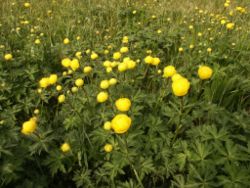| Lifespan: | ⌛ | perennial |
|---|
|
Trollius > |
If this plant info box on watering; zones; height; etc. is mostly empty you can click on the edit tab and fill in the blanks!
Trollius is a genus of about 30 species of plants in the Ranunculaceae, closely related to Ranunculus. The common name is globeflower or globe flower. They are native to the cool temperate regions of the Northern Hemisphere, with the greatest diversity of species in Asia, and usually grow in heavy, wet clay soils.
They are mostly herbaceous perennials with bright yellow flowers, though some have orange to lilac coloured flowers. The name "globe flower" refers to the petals of T. europaeus which are curved over the top of the flower to appear like a spherical globe; however, many of the other species have more open, flatter flowers.
All Trollius species are poisonous when fresh to cattle and other livestock, but their acrid taste means they are usually left uneaten. They are, however, used as food plants by the larvae of some Lepidoptera species including Silver-ground Carpet.
Some species are popular ornamental flowers in horticulture, with several cultivars selected for large and brightly coloured flowers.
Read about Trollius in the Standard Cyclopedia of Horticulture
|
|---|
|
Trollius (old German, trol, something round; trollblume, in allusion to the shape of the flowers). Ranunculaceae. Globe-flower. A group of neat hardy herbaceous perennials of a dozen or more species, mostly found in moist or marshy places of the North Temperate zone; useful in garden borders. Roots fibrous, thickened: lvs. palmately divided or lobed: fls. large, solitary, whitish, yellow, golden yellow, or purplish, those in cult. usually yellow- or orange-fld.; petals 5 to many, small, unguiculate, with a nectariferous pit at the base of the blade; sepals 5-15, large, usually constituting the showy part of the fl.; stamens many; carpels 5 to many, sessile, many-ovuled: follicles in a head.—Very like Ranunculus in general appearance, but distinguished at once by bearing follicles rather than achenes. Trolliuses are grown for the beauty of their globular flowers and show of dark green leaves. They are suited to wet sunken gardens, wild borders, and edges of water-gardens, although in a good garden soil not lacking in moisture they do well. They may be increased either by seeds or by dividing the old plants; but the young plants grow slowly at first, and will not flower before the second season from seed. The usual globe-flower of the horticulturist is T. europaeus, with incurving sepals so that the flower has a ball-like appearance; in most of the species the sepals spread nearly or quite horizontally. They bloom in spring and early summer. T. aurantiacus, Hort., described as lemon-yellow: probably a form of T. europaeus.—T. Excelsior, Hort., and T. hybridus, Hort., with deep orange fls., are probably T. europaeus forms. CH
|
Cultivation
- Do you have cultivation info on this plant? Edit this section!
Propagation
- Do you have propagation info on this plant? Edit this section!
Pests and diseases
- Do you have pest and disease info on this plant? Edit this section!
Species
About 30, including:
Trollius acaulis
Trollius altaicus
Trollius asiaticus
Trollius chinensis
Trollius dschungaricus
Trollius europaeus
Trollius farreri
Trollius japonicus
Trollius laxus
Trollius ledebourii
Trollius lilacinus
Trollius paluster
Trollius papaverus
Trollius pumilus
Trollius ranunculinus
Trollius yunnanensis
Hybrids:
Gallery
References
- Standard Cyclopedia of Horticulture, by L. H. Bailey, MacMillan Co., 1963
External links
- w:Trollius. Some of the material on this page may be from Wikipedia, under the Creative Commons license.
- Trollius QR Code (Size 50, 100, 200, 500)
